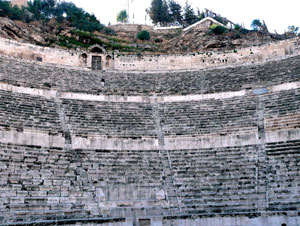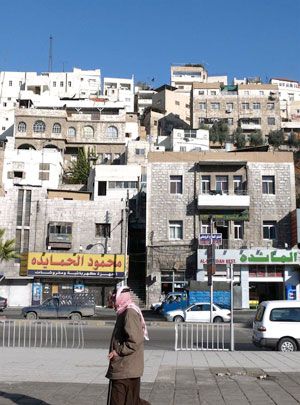AMMAN, JORDAN – Our morning wakeup call came unexpectedly at 4:30 a.m. when we were stirred by the amplified voice of a Muslim holy man calling worshippers to first prayer at a local mosque.
Jordan’s capital was still cloaked in darkness but already the streets below our hotel room were abuzz with life. The temptation to roll over and fall back to sleep was quickly dismissed because we were told one needs to get an early start to see all this often-overlooked storehouse of history has to offer.
While not as well known as other tourist destinations in the Middle East, Amman offers a variety of impressive historic sites that rival anything Cairo or Jerusalem has, plus features a vibrant nightlife, much of it centered on its lovely Old Tity.
After a quick breakfast, we met up with a local guide named Nimo – it’s recommended you purchase the services of a guide your first day here to get acquainted with local sites, customs and restaurants – and we headed out in the direction of the Citadel, a fortress perched atop the highest point in this place known as “the City of Hills.”
The neatly attired Nimo – suit and tie – welcomed us to “Philadelphia.”
Huh!?
“That is the name the Romans gave Amman,” smiled Nimo, who added, “I like to confuse Americans by calling Amman by its Roman name.”
Amman, or Philadelphia, was a well-established city when the Romans arrived in 63BC - archeological digs here have established the city dates back 500,000 years, to the Paleolithic period when Neanderthal man hunted around Azraq, located just east of Amman.
Reminders of the Roman occupation are everywhere. A perfectly preserved 8,000-seat Roman amphitheatre is still used today for concerts and the small museum attached to the site is truly enlightening.


Left: The Roman amphitheatre still holds concerts. Right: The old city and its markets are always active.
Nimo meets some fellow guides sipping tea and sharing gossip in the small garden in front of the amphitheatre entrance and he encourages us to tour the site on our own. “I have been inside many times, so please enjoy,” he said. “It is very safe to walk around Amman.”
After exploring the ruins, we decide to wander the hilly neighbourhood streets that connect Amman’s upper and lower towns and get a taste of local life and some sweet date treats we bought at a local coffee shop.
The Citadel is one of the most impressive ruins in the Middle East and one of the few that features both Greek and Roman architecture at one site. Gleaming white Greek columns that once held up impressive structures, stand out against the almost always present blue sky that hangs over the Jordanian capital.
Local guides are not allowed on the site so Nimo points us up the hill to the main entrance and urges us not to miss the museum because “it holds some of the Dead Sea Scrolls.”
The hilltop Citadel is truly spectacular and gives visitors a panoramic view of Amman and its many wonderful buildings, including the amazing royal palace where Jordan’s royal family calls home.
Jordan is one of the most stable countries in the Middle East and has good relations with all its neighbours, including bordering Israel. In fact, Jordan has brokered many Mideast peace initiatives and is home to a large Palentinian population, all of whom enjoy all the benefits of Jordanian citizenship.
Much of modern Amman is built with the same white limestone used in the construction of the ancient Citadel. When the sun is at its highest point of the day, it casts the city in an angelic glow and the sight is quite breathtaking.
After touring the Citadel, we met up with the chain-smoking Nimo and were off again to tour the city’s Old Town and enjoy its souks (markets), wander its narrow streets where we walked in the faded footsteps of just about every important biblical character – less we forget that there were no defined borders in Jesus’ time – and had our first experience with a “hubbly bubbly” – a pipe smoking device called a hookah but what’s locally known as a hubbly bubbly which every tourist, even those who don’t smoke, must try and bring home as a souvenir.
The traffic in the Old Town during the day is always congested so Nimo suggested we park the mini-van and walk the last kilometre to the market entrance.
We quickly got caught up in the excitement of the market, which is open every day but “really is packed with people on Friday nights,” according to Nimo.
Gold trinkets, fabrics of every kind, fruits and vegetables, freshly killed meat hanging in the mid-day sun, grains and spices and lots of excited chatter kept us entertained for hours before Nimo suggested we duck into the Bel Mondo Café to sample a “cherry hubbly bubbly” – Nimo’s favourite.
The Bel Mendo caters to smokers and they come in all ages – the hubbly bubbly is “not addictive,” according to Nimo, who then added, “I must have my hubbly bubbly at least three times a day or it’s not a good day.”
It was while we were enjoying our hubbly bubbly that Nimo filled us in on some more facts about his impressive city, including that the royal palace spreads out over a five-kilomtre-wide radius but is now used mostly for ceremonial purposes.
“King Abdullah and his family live in a new house in the modern area of Amman,” said Nimo.
The best time to visit Amman, Nimo told us, “is between March and April and then October through December,” because the summer heat can be quite stifling.” Amman sits it a wadi (valley) and the mountains that surround it trap the hot air in the summer months, which makes it quite uncomfortable for visitors.
Interestingly, Nimo told us that Jordanian monarchs usually never marry Jordanians – “there are many important families living in Jordan and to pick the daughter of one of those to marry over another would be seen as a great insult by the others.”
The hubbly bubbly was running out of smoke so Nimo ordered a fresh “pot” and while we waited told us that 50 per cent of his country’s 5.2 million population is made up of Palestinians and most live in Amman, a city with over 2 million people crammed in a very small area.
Unlike other Mideast countries, Jordan has no oil and survives mostly on tourism – its largest industry.
“Tourism was up 6 per cent last year,” Nimo told us, “When there are no wars here (in the area) many foreigners come – they like to see our country and we like to see them.”
The hubbly bubbly finished, Nimo dropped us off at our Four Seasons Hotel and bid us farewell. We felt bubbly after the day tour – the ancient sights, modern sounds and hubbly bubbly make Amman an intoxicating place to visit.